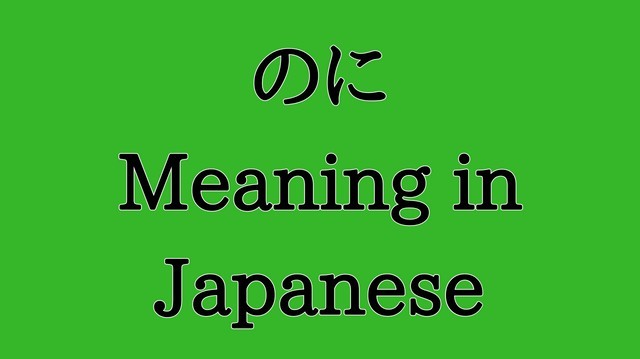Every now and then you learn a piece of Japanese grammar that then begins to appear everywhere you look. I’m going to go into detail on one of those today and explain the meaning of noni in Japanese.
The main thing about noni (hereon referred to as のに) is that most books explain one or two of its common usages, which is very useful, but then they leave out some of the larger patterns that のに is involved in.
From my own experience, I can tell you that they aren’t always to easiest to track down and learn. That’s exactly why I’ve created this one-stop lesson which aims to give you everything you need to know in order to understand のに.
のに is a Particle, and Here’s How it’s Used
For those of you who love grammar (why would you do that to yourself?!) you’ll be interested to know that のに is nothing more than the phrase nominalizer の, plus the particle に, which in this case indicates adverbial complement of intention.
Yes, I copied that explanation from a book. No, I don’t know what it means!
Look, I’m trying to provide you with a simple way of understanding のに so that you can begin to use it right away.
So let’s think of のに as a super useful particle, and start taking a look at how it’s used in Japanese.
The first usage of のに is to express the intention or aim of an action. In English, it would translate into either “for, for the purpose of, to, in order to” just depending on which sounds most natural in English.
This becomes a lot more apparent when you see it in action in Japanese phrases. So let’s take this opportunity to go over some of them now.
I used a knife to cut the bread.
パンを切るのにナイフを使った。
My bike is convenient for going to school.
学校に行くのに僕の自転車が便利だ。
Now there are a couple of things that you should know about this particular usage of のに before we move on to the others.
The first is that this usage is very similar, in fact almost identical, to that of ために.
The second is that のに can only be used after the dictionary form of verbs. For example, 切る and 行く are good, but forget adjectives, nouns, conjugated verbs, etc.
The next usage that we are going to go over is actually much more common, so if you came to this article trying to figure out what のに means, this is probably it.
The Most Common Way to Use のに

If you look up のに in a dictionary, the top definitions are “although; in spite of…” (you can read that above picture, right!)
This is good to know, but not really enough as it doesn’t help when understanding how to use it correctly.
Basically speaking, it works very similarly to the way けど (but) works in Japanese: It’s used to connect two clauses that are opposed in meaning.
Although the weather is nice, I can’t go outside.
いい天気なのに、出られない。
The main difference between けど and this particular use of のに is that, のに has an emotional feeling to it.
Usually it’s a negative feeling like frustration, anger, annoyance, but sometimes it’s used to express surprise at an occurrence.
Despite it being Monday, it is quite busy.
月曜日なのに、かなり賑わっている。
When there is a situation where you expect or desire for one thing to happen, but it doesn’t (or the opposite thing happens) that is usually a good use of のに.
Now, there will be many times in casual speech where you hear a sentence end in のに and it usually has this same meaning as the above examples, it’s just used to “end” an uncompleted thought.
Even though I studied… (I still failed the exam)!
勉強したのに!
Despite that fact that I was behind you… (you still saw me)?
後ろにいたのに?
This pattern of ending with のに can also sometimes be translated as the English phrase “and to think that…”
And to think that it was sunny just ten minutes ago… (but now it’s raining)
十分前はまだ晴れていましたのに…
And to think that he’s so rich…
彼はすごく金持ちなのに…
Can you hear the disappointment in that last one?
The なくても いい のに Pattern
We’ve covered the stuff that you can find in most textbooks that teach Japanese. Now I’d like to switch over to some larger patterns that use のに and explain how to understand them.
Personally, I’ve got about four different books that explain various aspects of Japanese grammar, and none of them go over this pattern (or the next section, for that matter). So unless you yourself have some high level stuff, chances are pretty good that this will be new to you.
Or it could also be that this is the exact reason why you are here. To learn this pattern (or the next).
Now I call this one the “なくても いい のに Pattern” which is technically a misnomer, because it’s actually the combination of just the なくても いい pattern and the particle のに, but due to the way the natural English translation sounds, I find it to be more helpful to just teat it like one big beast.
Basically, for those who are new, the なくても いい pattern is used with verbs to give someone permission not to do an action. It’s like literally saying “if you don’t do [verb], it’s okay.”
So for example, the verb 言う means “to say” in Japanese and in this pattern it looks like this:
言わなくてもいい
It’s okay if you don’t say / tell me.
You don’t have to say (anything).
Then you tack on the のに particle and it functions as that disappointment feeling that we went over in that last part.
So let’s put it together and first look at the literal translation, and then finally get to the one that feels natural.
言わなくてもいいのに
Despite the fact that it was okay if you didn’t say anything… (you did anyway and now I’m upset).
That’s quite a mouthful, and half of it is still unspoken due to the nature of のに. So what’s a more natural way of interpreting this pattern? What do we say in English that basically means the same thing?
Here it is: You didn’t have to [verb].
In this case we can translate 言わなくてもいいのに as simply “You didn’t have to say (it/that/etc.).”
Let’s take a look at a few other examples now.
You didn’t have to get up so early.
こんなに早起きしなくてもいいのに。
We don’t have to go home right now (so why do you want to?)!
今帰らなくてもいいのに!
So to summarize, this pattern is used when a person does something, but they didn’t have to, and you feel kind of a negative emotion because of it (hurt, angry, annoyed, etc.).
The ば いい のに Pattern

This ば いい のに pattern can cause a lot of confusion because there are two potential meanings, and you really have to pay attention to the context of the situation in order to figure out which one it is.
The first one is used to say “You should do [verb]” when you usually expect the opposite from the person.
You should go (even though you don’t want to).
行けばいいのに。
You should study more (even though you never do).
もっと勉強すればいいのに。
Now the other way to understand this ば いい のに pattern is the English phrase “I wish [verb] would happen.”
Again, using のに has that connotation that you don’t really expect it to happen.
I wish it were cheaper.
もっと安くなればいいのに。
You could also interprete it as “If only [verb] could be true” but again, you’re miffed that it’s not. Using that same phrase again:
If only it could be cheaper.
もっと安くなればいいのに。
Now in a way, these two patterns can be considered the same. Basically, you are expressing your desire for one state of being to be true, while at the same time believing that it won’t.
You should give me a call beforehand (when you come over)!
I wish you would call before just showing up!
前もって電話ぐらいしてくれればいいのに!
Here’s the thing to keep in mind, we are getting further and further into the parts of Japanese that don’t line up nicely with English.
This is one of those situations where you only loosely want to hold onto the English translation, and instead you really want to understand the ideal or feeling that is being expressed in Japanese.
As a final pattern in this section, it is also common to conjugate the いい verb into its past form 良かった.
This changes it from a present or future tense situation, into something that has already happened. In this case, it can really only be expressing a form of regret that something you wanted to happen, did not.
I wish that (it would have been better if) the door had closed (but it didn’t).
ドアが閉まれば良っかたのに。
Did I Miss Anything?
Now there may be more patterns out there that use のに (in fact, there most likely are) but these ones that I’ve gone over today are the most common that I have encountered.
If, by chance, your questions wasn’t answered with anything in this article, then please let me know with a comment below and I’ll see what I can do to help you figure it out.
As a final note, I decided to forgo adding furigana or vocabulary lists to this post. If that made it difficult for you to read, then check out these Google Chome Extensions that can help you learn Japanese.
One of them adds furigana automatically to any web page!
Further Resources for Learning Japanese:
#3 Get My eBook (Secrets to Learning Japanese) for Free

またね!

説明してくれて、ありがとうね?
I find ‘noni’ popping up on almost every page I read in both manga and novels. Very useful to learn.
いやいや, my pleasure man. のに would definitely be considered essential grammar when it comes to Japanese. Every student’s gotta learn and understand it at some point, so I wanted to help out with that.